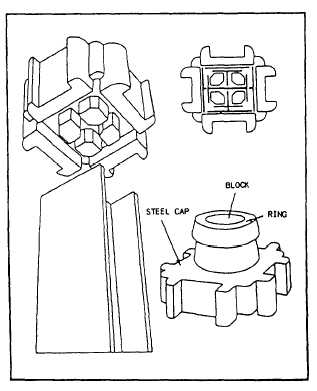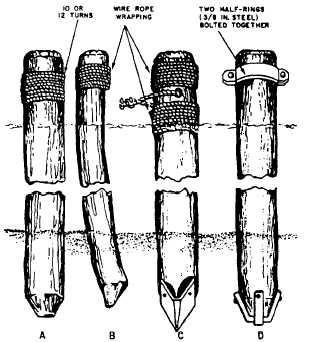driving cap is used, the chamfered butt must fit the cap.
When a cap is not used, the top end of the pile is wrapped
with 10 or 12 turns of wire rope at a distance of about
one diameter below the head of the pile (fig, 10-9, views
A and B). When a hole is bored in the butt of the pile,
double wrappings are used (view C). The pile can also
be wrapped or clamped if the butt is crushed or split. As
an alternative to wrapping, two half-rings of 3/8-inch
steel are clamped around the butt (view D).
The tip of the pile is cut off perpendicular to its axis.
When driven into soft or moderately compressible soil,
the tip of the pile may be left unpointed. A blunt-end
pile provides a larger bearing surface than a pointed-end
pile when used as an end-bearing pile. When driven, a
blunt-end pile that strikes a root or small obstruction
may break through it.
Where soil is only slightly compressible and must
be displaced, the tip of the pile is usually sharpened to
the shape of an inverted truncated pyramid (fig. 10-9,
view A). The blunt end is about 4 to 6 inches square;
the length of the point is 1 1/2 to 2 times the diameter
of the pile at its foot. A crooked pile maybe pointed for
driving, as shown in view B.
For hard driving, steel shoes are used to protect
the pile tips. A manufactured shoe is shown in view
C, and an improvised steel shoe is shown in view D.
Steel Bearing
Steel ranks next to timber in importance,
especially where the construction must accommodate
heavy loads or the foundations are expected to be used
over a long period of time. Steel is best suited for use
as bearing piles where piles must be driven under any
of the following conditions:
Piles are longer than 80 feet.
Column strength exceeds the compressive
strength of timber.
To reach bedrock for maximum bearing surface
through overlying layers of partially decom-
posed rock.
To penetrate layers of coarse gravel or soft rock,
such as coral.
To attain great depth of penetration for stability
(for example, driving piles in a rock-bedded,
swiftly flowing stream where timber piles can-
not be driven deeply enough for stability).
One of the most common types of steel bearing
piles is the pipe pile. An open-end pipe pile is open at
the bottom. A closed-rid pipe pile is closed at the
bottom. Another common type of steel pile is the
H-type, often seen as HP. When driving HPs, a special
driving cap (shown in fig. 10-10) is used.
Figure 10-9.-Preparation of timber piles for driving.
Figure 10-10.-HP-bearing pile and special cap for driving
10-5



